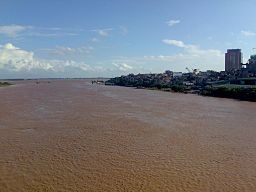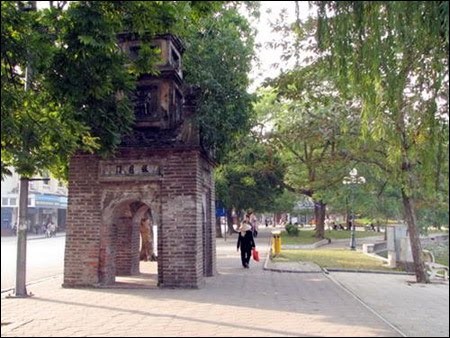A: Welcome to VOV’s Letter Box. This feature airs every Wednesday. As usual many of the letters and emails sent to us are questions about Vietnam. This week, Ratan Kumar Paul, a teacher and coordinator of the South Asia CRI DXER forum in Dakshin district, Indian state of Bengal, said he wants to know more about the Red River and pagodas in Hanoi.
 |
| The surface of Red River in the flood reason (the photo taken near Hanoi) |
B: Thank you Ratan, we’re glad to tell you a little about the Red River, and the section passing through Vietnam and our capital city of Hanoi. Beginning in China's Yunnan province, the Red River enters Vietnam at the northern province of Lao Cai and forms a portion of the international border between China and Vietnam. The upper stretch of river, also known as Thao River continues its southeasterly course through northwestern Vietnam before emerging from the mountains to reach the midlands.
A: Downstream from Viet Tri, the river and its many tributaries spread out to form the Red River Delta. The Red River flows past the capital Hanoi before emptying into the Gulf of Tonkin which is the former name of Northern provinces in Vietnam.
B: The reddish-brown, heavily silt-laden water gives the river its name. The Red River is notorious for its violent floods with its seasonal volume fluctuations. Because the delta is the second largest rice growing granary in the country, the land is protected by an elaborate network of dikes and levees.
A: That’s an overview of the Red River, the section flowing through Vietnam and Hanoi. Now let’s tell you something about the network of pagodas and temples in Hanoi, we must say that they are one of many elements making up the richness of the thousand years of history of Hanoi. There is a temple or pagoda in most communes or wards in Hanoi and there are also many books written about them by both Vietnamese and foreign authors.
 |
| The Hoa Phong/Favorable Winds Tower is located on the pavement of Dinh Tien Hoang St., east of the Sword Lake (Photo: TTO) |
B: And today we’ll introduce to you the network of temples and pagodas around Hoan Kiem or Sword Lake located in the heart of the city. Bao An pagoda which should be mentioned first as its one of historical significance to Hanoians. It was constructed in the early 1840s with funds from a public subscription launched by the then governor of Hanoi, Nguyen Dang Giai. The building was octagonal with the walls representing the eight petals of a lotus flower. On the east side, the Pagoda was adjacent to a dyke and on the west it overlooked Hoan Kiem Lake. However, from 1886 to 1889, the pagoda was gradually razed for the construction of modern buildings to serve the French administration.
A: Although Bao An pagoda is gone, it is not forgotten as a final vestige left is the Hoa Phong or Favorable Winds Tower which still remains on the edge of the lake opposite the Central Post Office. Originally it served as an entrance gate to the pagoda complex and was now stands as a relic. Architecturally, the tower is small in scale and four entrances symbolize the wish for favorable winds for each of the four seasons.
B: Though Bao An pagoda can now be known only via historical materials, what is left and can be seen if you have an opportunity to visit Hanoi, perhaps more beautiful.
A: In addition to Bao An pagoda, other places that should not be missed are Ngoc Son and Ba Kieu temples, Nam Huong communal house, and Ba Da pagoda as well as legends and stories behind such places. Through them you can turn back time and imagine how Hanoi was in the past.
B: Dear Ratan, we hope that in the future, you will manage to visit Hanoi and when you do, be sure to visit the Sword Lake in either early morning or evening. Believe me you will enjoy the place by seeing what I mentioned above and the daily life of Hanoians today.
B: You’re listening to VOV’s Letter Box, broadcast every Wednesday. The song you just heard was about the Red River performed by Phuong Thanh. Now let’s check other letters and emails we received during the week.
A: Bhaika Hazarika, C/O of the Universal DX Club in Assam in India listened to our program on January 14th at 16.19 UTC at frequency of 9550 kHz. He said he loved the broadcast, especially the segment about Vietnam’s land and people which on that day was about a flower village about 100 km south of Hanoi. The report helped him feel closer to Vietnam and its various beautiful places.
B: You’re right, Bhaika. Flower villages in and near Hanoi are now in their most beautiful bloom, especially the villages growing peach flowers, traditionally used for Tet decoration. The village you heard in that report was Vi Khe village, 100 km south of Hanoi.
A: At the outlying areas of Hanoi, there are many flower growing villages such as Nghi Tam, Quang Ba, Ngoc Ha, Huu Tiep, and Dai Yen. Overtime, due to the expansion of the cities and rapid population growth, the traditional flower villages are shrinking. Flowers-growing area’s are squeezed into small gardens between the buildings. Meanwhile, many new flower villages around the capital are gradually gaining ground and flourishing such as Tay Tuu, Vinh Tuy, and Phu Thuong.
B: But referring to the traditional flower villages in Hanoi, people speak the most of Ngoc Ha, and it has even appeared in folk verses such as:
Ngọc Hà’s well is clean and fresh
Ngọc Hà’s garden brings its perfume every where
I would like to ask the gardener
Whether you permit any one to come in here?
A: In 1954, there were up to 500 households in this village involved in planting flowers. Ngoc Ha villagers grow many kinds of flowers originating from temperate regions’ flowers like the peach blossom, daisy, violet and lily. The winter to spring conditions of drizzling rain and cold wind is suitable for growing these types of flowers. Early every morning, the Ngoc Ha flower market is full of buyers and sellers.
B: Dear Bhaika, we wish you could come to Vietnam during this time of the year. It’s so beautiful! On top of being beautiful, flowers are a native product with its own economic value as well as cultural and artistic value. It obviously is becoming an industry of considerable profit for many countries in the world and is not exceptional for Vietnam. Recently, flower growing has brought enormous interest for society, the economy as well as for the environment. And planters in these villages are trying to create new varieties of nice and unique flowers along with the familiar varieties like chrysanthemums and roses.
A: Hanoi is actually interested in developing flower-growing areas in the suburbs to set up a flower ring around Hanoi, making the "city of peace" more colourful. On every Letter Box show, we try to mention as many listeners as possible, so hello, Dmitriy Puzanov from Kazakhstan, who listened to the English program January 6th on 9730 kHz, Fachri from Pekanbaru in Indonesia who listened to an English broadcast on on January 16th on 9840 kHz; Toshiya Nishimura from Hinode Fukui-shi Fukui, Japan. He is one of our very regular listeners and this time, he tuned in to our program on January 16th on 9840 kHz.
B: Mubashir Hussain Asher, President of PAK Listeners Club in Muzaffargarh, Pakistan; Michael Stevenson from Port Macquire in Australia, and Mohamed Elsayed Abd Elraheim from Elsharkya, Egypt who emailed us to express his thanks for producing radio broadcasts that have helped him ‘enjoy seeing Vietnam and the world through VOV’. And more and more listeners sent us either postal or electronic mails.
A: All these listeners sent us letters or emails with reports of the English programs they heard and comments on technical aspects and program content. We greatly appreciate this feedback. Dear listeners, your reception reports were all complete enough for us to send you letters of confirmation. If your name wasn’t mentioned this week, don’t feel left out. We’ll try to acknowledge you next time.
B: That’s it for today’s Letter Box. Please keep in touch. We look forward to receiving your comments and suggestions. Our contact address is:
The English program,
Overseas Service, Radio Voice of Vietnam,
45 Ba Trieu Street, Hanoi, Vietnam
B: Or you can email us at: englishsection@vov.org.vn. If you miss any of our programs, you can always catch up by logging onto our website at: www.vovworld.vn, where you can hear both live broadcasts and previously recorded programs.